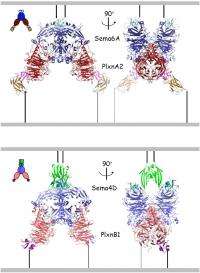Understanding how cell semaphorins and plexins interact

Axons are the communication channels of the body. Up to a metre in length, they connect parts of the body to the brain, carrying signals from muscles, organs and tissues. As the central nervous system develops these axons must follow very precise paths through the body. The route that they take is guided by proteins, which signal paths that the axon should and shouldn’t take. A group of proteins called semaphorins are known to be responsible for directing axons away from inappropriate areas.
However in recent years there has been increasing evidence that semaphorins and their receptors, plexins, also play a role in a number of processes including the progression of cancer. Scientists from the University of Oxford have been studying how semaphorins and plexins interact to understand how cells send signals to each other.
This research has been published in the journal Nature.
Semaphorin-plexin signalling has received a lot of attention over the last decade, for the role it plays in neural connectivity, cancer and immune response. However until now there has not been any structural information on the extracellular parts of the plexin, so the mechanism of semaphorin interaction hasn’t been resolved. The group from the University of Oxford have been using I03, one of the Macromolecular Crystallography beamlines at Diamond to determine the structure of the semaphorin-binding regions of plexins and understand the mechanism on the molecular scale.
The group found that semaphorin dimers independently bind two plexin molecules, and the signalling ability of the resulting complex depends on the strength of the combined bonds – monomeric semaphorin can bind to plexin but doesn’t result in signalling.
“The data we collected at Diamond have allowed us view in atomic level detail the triggering of the signals that help wire up our nervous system," said Professor Yvonne Jones, University of Oxford.
More information: Structural basis of semaphorin–plexin signalling, Bert J. C. Janssen, et al. Nature, Sept 2010 DOI: 10.1038/nature09468
Provided by Diamond Light Source

















